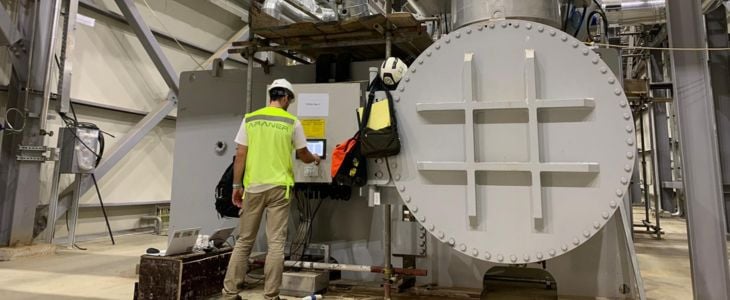The water-to-water heat pump represents a key development for operators looking to decarbonize their projects and access sustainable, efficient heating and cooling equipment.
The need for reducing carbon emissions is driving demand for systems such as seawater heat pumps, which today represent one of the leading efforts in sustainability.
Water-to-water heat pump: a definition
A water-to-water heat pump is a type of heat pump that transfers heat between two water flows (a source and a sink).
Simply put, it operates on the same basic principle as conventional heat pumps but uses water as the medium for heat transfer. As such, it is able to extract the heat energy present in water to provide both heating and cooling. In fact, suitable water sources may include ground water, cooling water from industrial processes , process water that is chilled before use or even sewage water. Actually, even rivers and seawater can be used as a heat source.
They represent a versatile solution for both heating and cooling applications: during heating mode, they extract heat from the water source and deliver it to the heating system; in cooling mode, the heat pump operates in reverse, so that it extracts heat from the building and rejects it into the water source.
Water-to-water heat pumps use in residential, commercial, and industrial applications is growing more and more in the last few years and it is expected to keep growing. While they can be integrated with hydronic systems, they are also used in combination with fan coil units or other water-based distribution systems.
This peak in the use of this type of heat pumps is mainly due to their outstanding performance and efficiency. As such, research by Petteri Aalto looking at seawater heat pumps recently showed a total heating energy coverage of 77%, and an average COP of between 4.6 and 2.8 (depending on the season). This concurs with figures by ASHRAE (American Society of Heating, Refrigerating and Air-Conditioning Engineers), where seasonal COP for this type of heat pump varied between 2 and 4.
The types of water-to-water heat pumps
- The open loop systems lift water from a borehole to the surface, from which they extract heat energy, then returning it to the cooled water in a separate borehole. This type of water-to-water heat pump doesn’t involve the use of antifreeze, so adequate flows of water and sizing must be ensured to avoid freezing risks. They are able to move big quantities of water, thus leading to great efficiencies but may present higher operation and maintenance costs.
- Closed loop systems rely on sealed pipes filled with antifreeze fluid. As this liquid is circulated through the pipes, it retains heat energy in the water. This type of water-to-water heat pump is a common choice for lakes and large ponds.
How does a water-to-water heat pump work?
The water-to-water heat pump consists of three main components: the evaporator, the compressor and the condenser.
The first is in charge of extracting heat from a water source by circulating a refrigerant through a series of coils. As the refrigerant evaporates, it absorbs heat from the water source, which causes the water temperature to decrease.
The vaporized refrigerant is then compressed by a compressor, an operation which raises its temperature and pressure. Now turned into a high-temperature, high-pressure refrigerant, it passes through a condenser where it transfers its heat to another water distribution system.
In the condenser, the refrigerant releases heat to the second water flow, which is then used for heating. As the refrigerant gives off its heat, it condenses back into a liquid state, ready to start the process again.
When cooling is needed, the water-to-water heat pump works on the same principle but following the steps in reverse: condensation, compression and evaporation.

The benefits of a water-to-water heat pump
- Water-to-water heat pumps are known for their high energy efficiency. They can achieve high coefficients of performance (COPs), thus helping in reducing energy consumption and lower utility bills. They present a higher efficiency compared to other alternatives, such as air-based heat pumps. As such, water-to-water heat pumps typically present COPs in the range of 2.8 to 4. However, these values will depend on the difference in temperature between the heat source and the heat sink, so that the warmer the heat source and the colder the heat sink , the higher the heat output and efficiency.
- Water-to-water heat pumps are a route for renewable energy integration, maximizing the use of clean, sustainable energy. As such, they are able to harness the constant temperature of the water source without relying on fossil fuels, thus reducing greenhouse gas emissions. They are consequentlya solid candidate in the quest to accelerate developments to meet net zero carbon emissions.
- This type of heat pump is also known for its outstanding versatility, providing both heating and cooling capabilities. As we’ve described above when looking at “how does a water-to-water heat pump work?”, they are able to effectively extract heat from a water source for space heating during colder months and transfer heat out for cooling during warmer months.
These benefits have turned the water-to-water heat pump into a solid candidate when it comes to decarbonizing heating and cooling structures. This is particularly true when combined with district heating initiatives, a centralized model that takes minimizing the environmental impact of heating to the next level.
At Araner, we help operators devise cost-efficient and sustainable heating structures. As such, we’ve been involved in the design and implementation of water-to-water heat pump initiatives that combine state-of-the-art technology and cutting-edge heating engineering to maximize results. Get in touch with our team and find out how we can help you.










